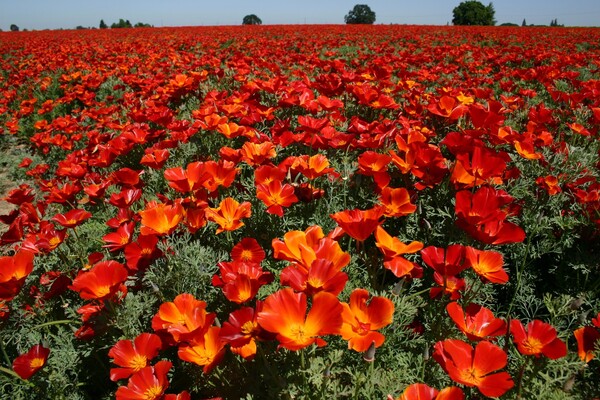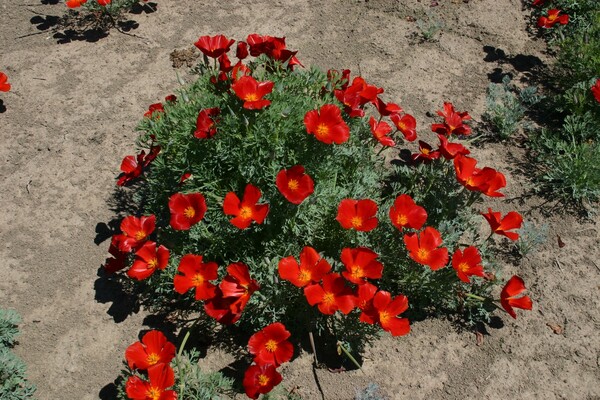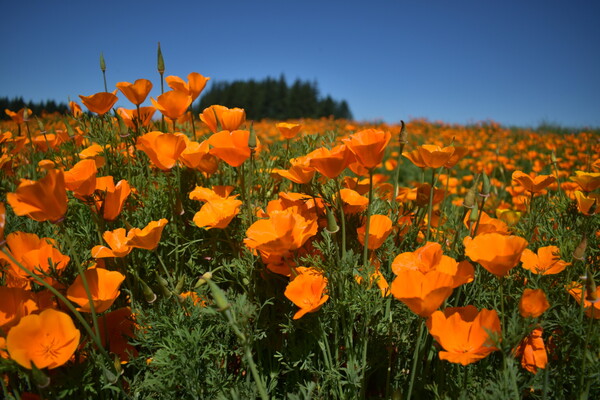Eschscholzia californica, commonly known as the California poppy or flower of the California state, is a perennial herb in the poppy family, renowned for its vibrant orange-yellow flowers. This beautiful and hardy plant has become an iconic symbol of California, widely celebrated for its role in local culture, medicinal properties, and ornamental value. Whether you are a passionate gardener or just curious about this stunning flower, this guide will cover everything you need to know about California poppy.
Kingdom: Plantae (Plants)
Phylum: Angiosperms (Flowering plants)
Class: Eudicots
Order: Ranunculales
Family: Papaveraceae (Poppy family)
Genus: Eschscholzia
Species: Eschscholzia californica
Eschscholzia californica is commonly known as the California poppy, a member of the poppy family (Papaveraceae), native to the southwestern United States.
Eschscholzia californica, also known as the California poppy, gold poppy, or even "Hunnemannia," is a herbaceous plant native to the southwestern United States and Mexico. The species was named after the German botanist Johann Friedrich Eschscholtz, who first described it. California poppies are known for their cheerful, bright orange or yellow blossoms, which bloom from spring to early summer. Although this perennial plant is often grown as an annual in gardens, it is drought-tolerant, cold-hardy, and relatively easy to grow.

Flowers: California poppies have distinctive, delicate flowers that are typically orange or yellow with darker orange spots at the base of the petals. The petals are fan-shaped, triangular, and measure about 2.5 to 3 cm in length. The flowers bloom singly at the top of the stems, creating a bright, striking display.
Leaves: The plant’s leaves are finely dissected and grey-green, creating a contrast with the bold flowers. They are typically 10 to 30 cm long and have a feathery appearance due to the fine segmentation.
Growth Habit: The plant is upright, with branching stems that can reach 30 to 60 cm in height. It is an herbaceous plant with a fleshy taproot system, which allows it to survive in dry conditions.
Fruit: After flowering, the plant produces narrow, cone-shaped capsules filled with tiny seeds. These seeds are ball-shaped, with a diameter of 1-1.5 mm and a distinct network of ridges.
While California poppies are known for their resilience and easy maintenance, providing the right growing conditions will help them thrive and flourish. Here’s a guide to growing and caring for Eschscholzia californica:
California poppies prefer well-draining, light, and somewhat sandy or loamy soil. The plant does not tolerate waterlogged conditions, so it's crucial to ensure the soil has good drainage. It grows best in slightly alkaline or neutral soil and should be free from heavy clay content.
This plant thrives in full sunlight, which is essential for optimal growth and flowering. It needs around 6 to 8 hours of direct sunlight daily. While it can tolerate some light shade, blooming may be limited in lower light conditions.
Eschscholzia californica thrives in cool to mild climates, especially those with dry summers. It is resistant to heat but prefers cooler temperatures between 15°C and 25°C (59°F to 77°F). The plant is highly frost-tolerant and can survive temperatures as low as -5°C (23°F).
Once established, California poppies are drought-tolerant and require minimal watering. It is important not to overwater the plant, as excess moisture can cause root rot. During dry spells, water moderately to keep the soil slightly moist, but allow it to dry out between waterings.
California poppies are typically propagated by seeds, which can be sown directly in the soil or started indoors. Seeds should be planted in the fall or early spring. For best results, sow seeds in well-prepared soil at a depth of about 1 cm (0.4 inches). Seeds should germinate in 7 to 14 days under proper conditions. Thin out seedlings to allow for proper spacing.
Regular pruning is not necessary for California poppies, but removing dead flowers (deadheading) will help extend the blooming period. In some cases, the plants may self-seed, creating new blooms the following season. To maintain a tidy appearance, cut back any spent flowers after blooming has finished.

While California poppies are relatively pest-resistant, they can occasionally face challenges like aphids, snails, and slugs. Overwatering may also lead to fungal issues like powdery mildew or root rot. Regularly inspect your plants for any signs of pest damage and take appropriate action when necessary. For pest control, you can use organic solutions such as neem oil or insecticidal soap.
California poppies are not just beautiful flowers—they also have notable medicinal properties. Historically, the plant has been used for its sedative and pain-relieving effects. The extract from California poppy is believed to have calming properties, helping to reduce anxiety and promote restful sleep. The plant’s analgesic effects are peripheral rather than central, meaning it works outside the nervous system to relieve pain without affecting the central nervous system like other opiate-based medicines.
California poppy extract has been used to treat anxiety, stress, and insomnia. It is believed that the plant’s calming effects may come from its interaction with benzodiazepine receptors, although it does not carry the same risk of addiction or side effects as pharmaceutical sedatives.
The plant has also shown promise as a mild pain reliever, particularly for conditions involving peripheral pain such as muscular aches or minor joint discomfort.
California poppies are not only valuable for their medicinal properties but are also stunning ornamental plants. Their vibrant, bright flowers make them a popular choice for:
Flower Beds and Borders: The vibrant flowers can create colorful, eye-catching displays in garden beds, flower borders, and meadows.
Ground Cover: With their low-maintenance nature, California poppies can also be used as ground cover in areas where other plants may struggle.
Containers and Pots: These plants do well in containers, making them a great option for patios, balconies, and other small garden spaces.
While California poppies are generally safe to handle, they do contain small amounts of alkaloids that can be toxic if ingested in large quantities. Direct contact with the leaves or stems may cause mild skin irritation in some individuals, so it is advisable to wear gloves when handling the plant. Ingesting parts of the plant can cause symptoms such as vomiting, diarrhea, or other gastrointestinal issues. Always keep the plant out of reach of children and pets.

As the official state flower of California, Eschscholzia californica holds a special place in American culture. The plant is celebrated annually on California Poppy Day (April 6th) and is featured on the California state highway signs. In addition to its cultural importance in California, the poppy’s bright orange flowers have come to symbolize resilience, hope, and renewal.
Eschscholzia californica, with its striking orange blooms and hardy nature, is a wonderful addition to any garden. Whether you're growing it for its beauty, medicinal benefits, or cultural significance, this plant is sure to bring joy and color to your space. Easy to grow and maintain, it’s an excellent choice for both novice and experienced gardeners alike. So, if you’re looking for a low-maintenance, vibrant plant, the California poppy is an ideal choice!
animal tags: Papaveraceae
We created this article in conjunction with AI technology, then made sure it was fact-checked and edited by a Animals Top editor.